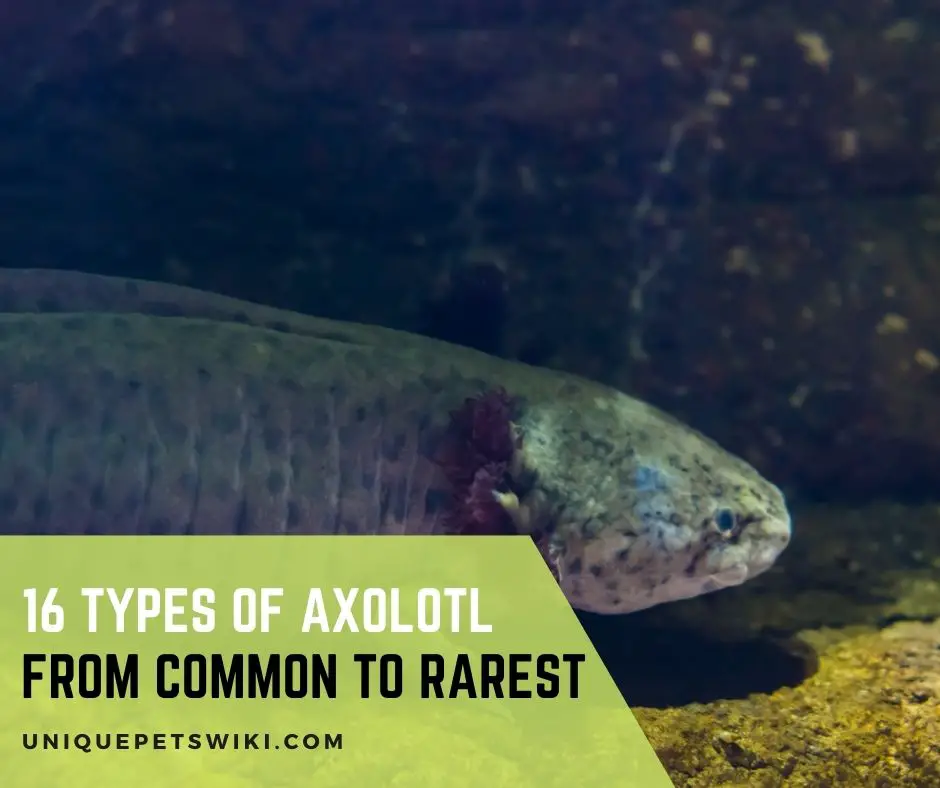Axolotls are salamander species that originate from a small region in Mexico. Axolotls are cute creatures and are among the most adorable pets that you can keep as a pet.
They are popular and unique pets, and a fascinating thing about them is that they can regenerate their limbs.
A great thing about axolotls is that it is available in a wide range of colors. The basic morphs of axolotls are wild, white albino, leucistic, melanoid, and golden.
However, there are also rare morphs, and choosing an axolotl is based on your preference and budget.
In this article, we will highlight everything you need to know about axolotl colors and the different axolotl morphs that are available.
Contents
- How Many Types of Axolotls Colors Are Available?
- Top 16 Types of Axolotl Colors from Common to Rarest
- Leucistic Axolotl or Lucy
- Speckled Leucistic, Dirty Leucistic Axolotl, or Dirty Lucy
- Wild Axolotl
- Golden Albino Axolotl
- White Albino Axolotl
- Black Melanoid Axolotl
- Copper Axolotl
- Green Fluorescent Protein Axolotl
- Heavily-Marked Melanoid Axolotl
- Piebald Axolotl
- Silver Dalmatian / Lavender Axolotl
- Firefly Axolotl
- Enigma Axolotl
- High Iridophore Golden Albino Axolotl
- Mosaic Axolotl
- Chimera Axolotl
- FAQs
- Wrapping Up
How Many Types of Axolotls Colors Are Available?
There are no fixed amount of color morphs of axolotls that are available. Wild axolotls are usually brown or tanned with golden specks and a greenish undertone.
However, the population of axolotls found in the wild is reducing over time due to urbanization.
The color morphs of axolotls available are a result of genetic engineering, and most of the colors are created in the lab. This is why there is a wide range of mutant morphs out there.
Nowadays, rare morphs are becoming more common because of higher demand from pet owners.
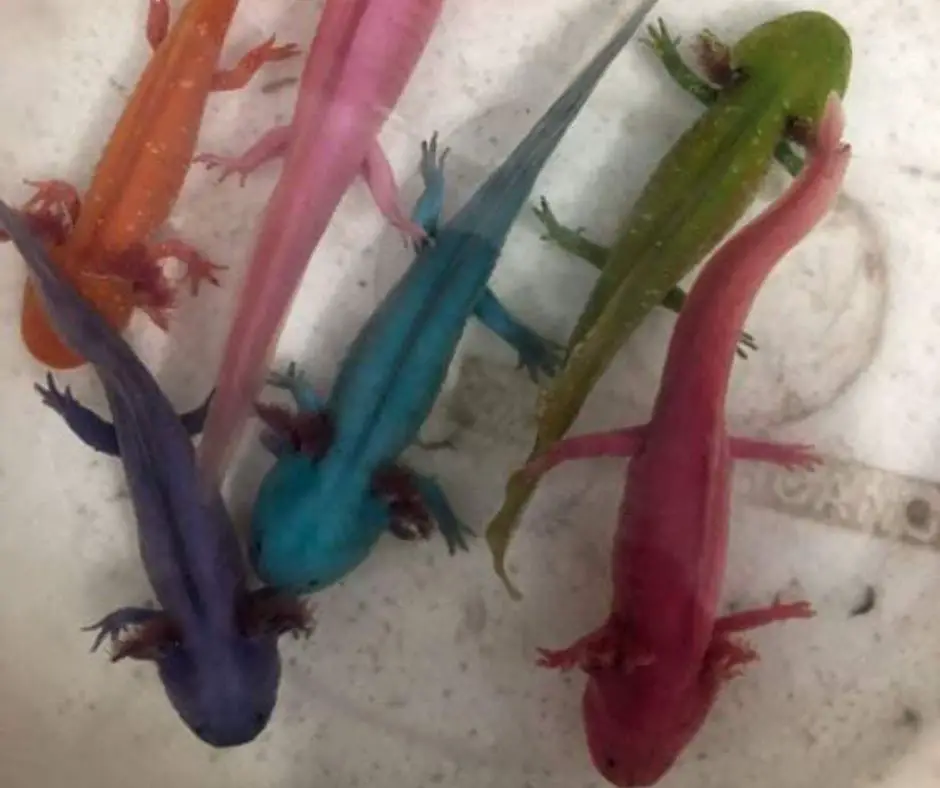
Why Do Axolotls Have Such Different Types of Colors?
Before you can understand why there are several axolotl morphs, you will need to understand their genetics. Chromatophores in the pigment-bearing cells decide the axolotl’s color.
Axolotls have three types of chromatophores called xanthophores, melanophores, and iridophores.
- Xanthophores are carotenoids and pteridines, and it causes yellow and red pigmentation.
- Melanophores comprise Eumelanin, and it leads to black or brown pigmentation.
- Iridophores are crystallized purines that lead to a shiny soap-bubble type of pigmentation.
Baby axolotls usually inherit their color through two separate genes (one gene from each parent). Each gene comprises three sections that code the three chromatophores types.
These sections are known as alleles, and the combination of the allele will increase or decrease the number of chromatophore types that will be produced in baby axolotl’s skin.
For instance, the alleles of an albino axolotl indicate low levels of melanophores in the skin. An axolotl will not be an albino if it has one single albino allele and one normal allele. Before it can show albino coloration, it will need two copies of the albino allele.
This is why breeding for a specific color is quite harder than others and affects the rarity of a certain axolotl color. However, many morphs are accidentally formed because of the mutation in the normal color alleles, which then causes unusual patterns or colors.
Breeders usually go through selective breeding and lots of patience before creating a color morph from a mutant species.
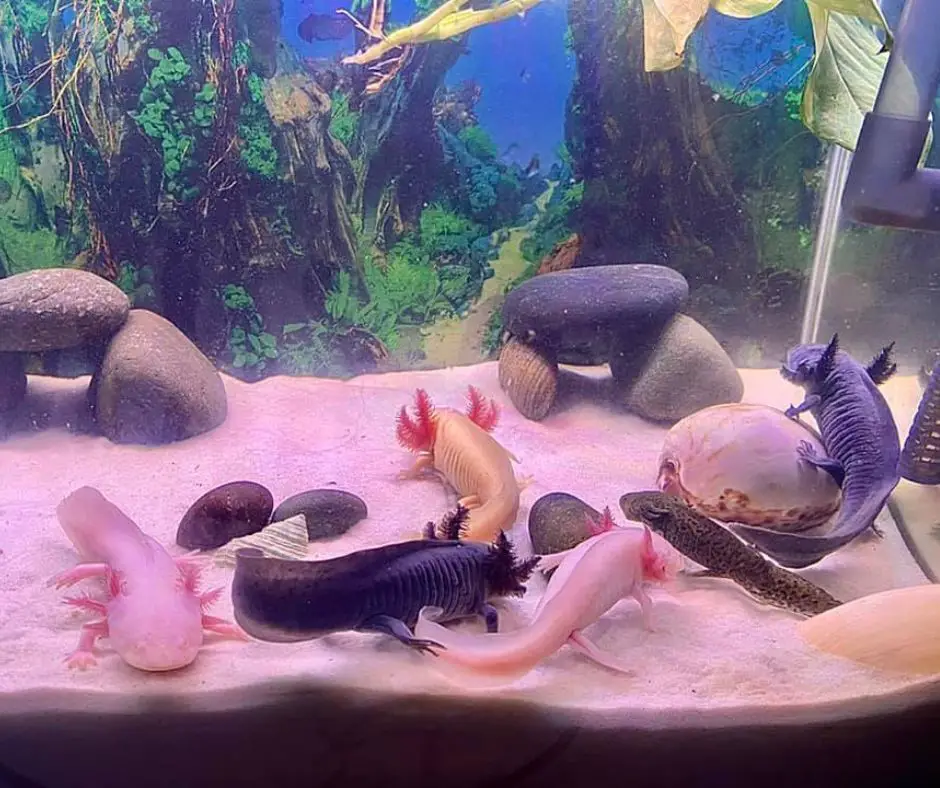
Top 16 Types of Axolotl Colors from Common to Rarest
There are several axolotl colors and in the table below we will show you some of the axolotl colors from the common type to the rarest type.
| Name | Available | Colors | Cost (around) |
| Leucistic Axolotl or Lucy | Common | Translucent white with shiny gold flecks | $45 |
| Speckled Leucistic Dirty Leucistic Axolotl or Dirty Lucy | Common | White base color with dark green, black, or brown speckles on their heads, backs, and tails | $50 |
| Wild Axolotl | Common | Black, green, and brown with shiny golden specks on their body | $40 |
| Golden Albino Axolotl | Common | Golden yellowish body | $50 |
| White Albino Axolotl | Common | Pure white with pink or white eyes | $40 |
| Black Melanoid Axolotl | Common | Completely dark | $65 |
| Copper Axolotl | Uncommon | Light gray body covered in copper-colored freckles and gray irises | $100 |
| Green Fluorescent Protein Axolotl | Uncommon | Green in color and can glow in the dark | $55 |
| Heavily-Marked Melanoid Axolotl | Uncommon | Dark with light green and yellow patches on their body | $75 |
| Piebald Axolotl | Rare | White body with dark green, black, or gray symmetrical patches on their face and back | $300 |
| Silver Dalmatian / Lavender Axolotl | Rare | Light, silvery purple color with black eyes and grayish-red gills | $115 |
| Firefly Axolotl | Rare | Dark in color with green fluorescent protein albino tails | $250 |
| Enigma Axolotl | Rare | Dark gray body with pale red gills | $1500 |
| High Iridophore Golden Albino Axolotl | Rare | Stunning iridescent colors | >$50 |
| Mosaic Axolotl | Very rare | Black, golden, and white flecks on their body | Not sold |
| Chimera Axolotl | Very rare | A morph characteristics on one side and another morph characteristics on the other side. | Not sold |
Leucistic Axolotl or Lucy
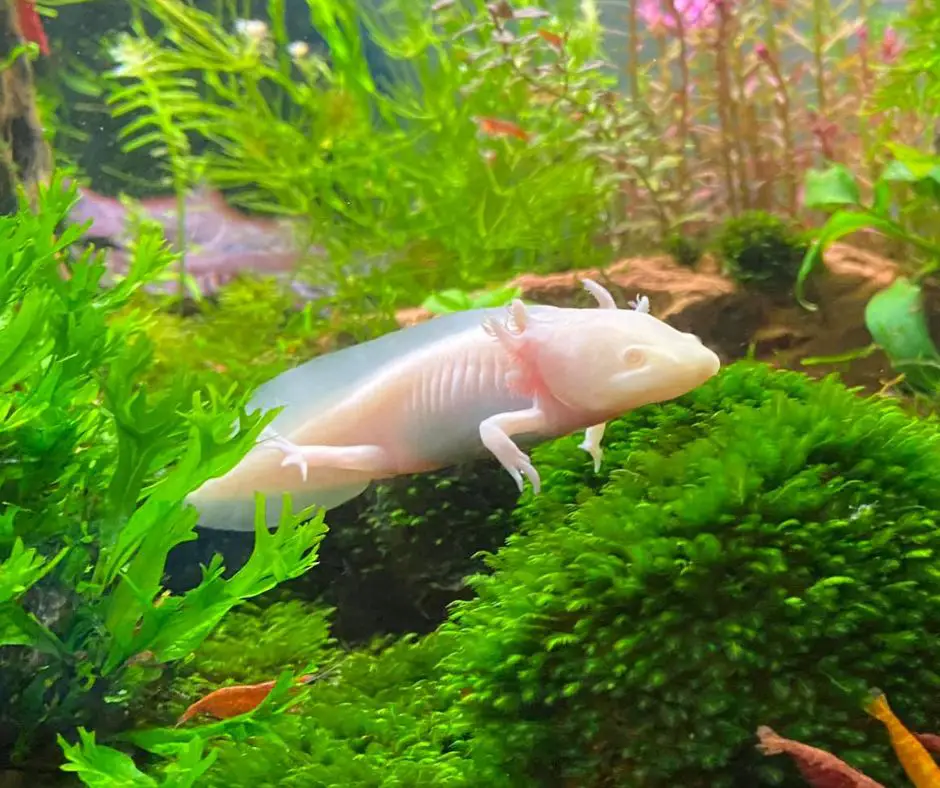
Leucism in axolotls is caused by the mutation, which causes the production of fewer melanocytes in their skin.
Leucistic axolotls, also called Lucy, are usually translucent white and have shiny gold flecks, dark brown or black eyes, and red or pink gills. Many mistaken leucistic axolotls for albino morphs.
However, albino axolotls have red eyes, while leucistic axolotls have brown or black eyes.
It is rare to find Lucy morphs in the wild as they can be spotted by predators easily. Leucistic axolotls are beautiful morphs, and they are very common in captivity.
Speckled Leucistic, Dirty Leucistic Axolotl, or Dirty Lucy
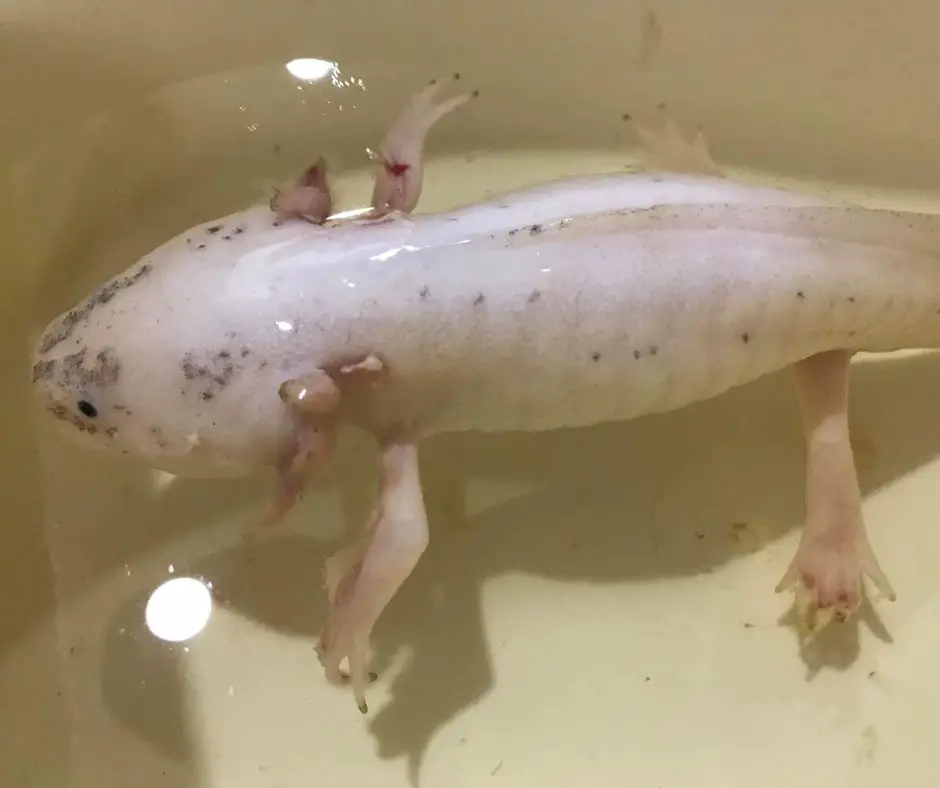
Speckled leucistic axolotls or dirty lucy is a kind of leucistic mutation.
These axolotl morphs usually look identical to a leucistic morph in the beginning and will then develop speckles as they grow up. Their pigment cells will also mature while growing, which helps their color and freckle pattern change.
Dirty Lucy usually has dark green, black, or brown speckles on their heads, backs, and tails. They also have a white base color, just like normal leucistic morphs.
However, the amount of speckling on their body is not as prominent as the mosaic or piebald axolotl morphs.
Wild Axolotl
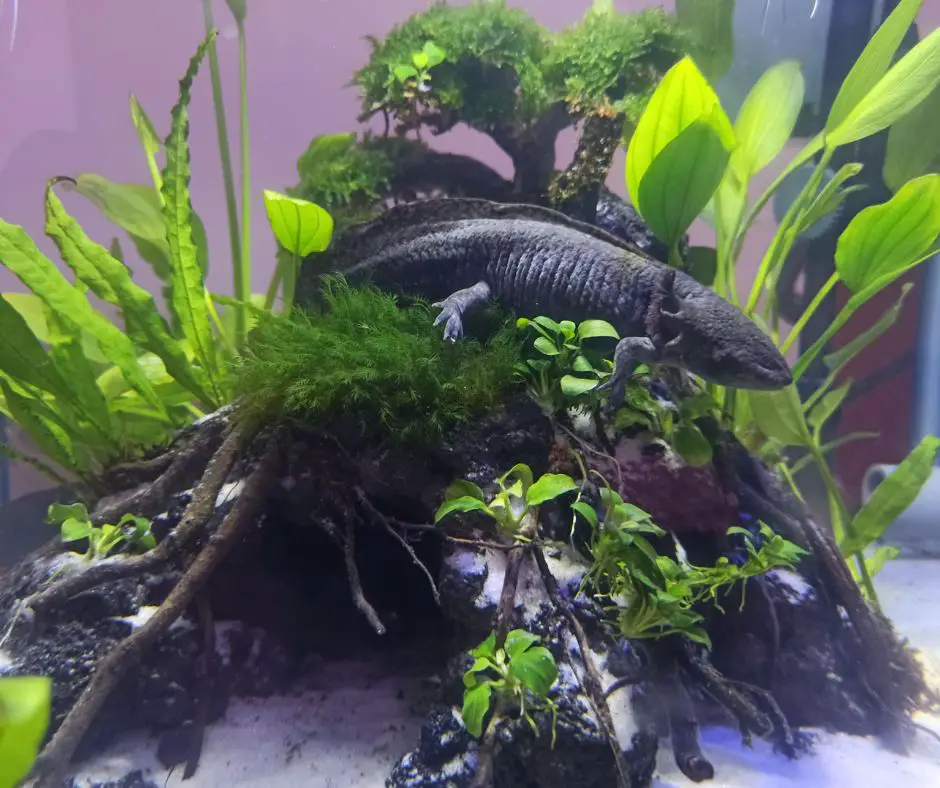
Generally, wild axolotls are mostly found in nature. You can identify them by their darkish shade with shiny golden specks on their body.
Their base body color is a combination of black, green, and brown. Their color helps them to blend well underwater to keep them safe from predators.
As wild axolotls grow older, they turn darker and look similar to the melanoid morphs. However, you can differentiate between the two morphs by the presence of a shiny golden ring in their eyes.
Golden Albino Axolotl
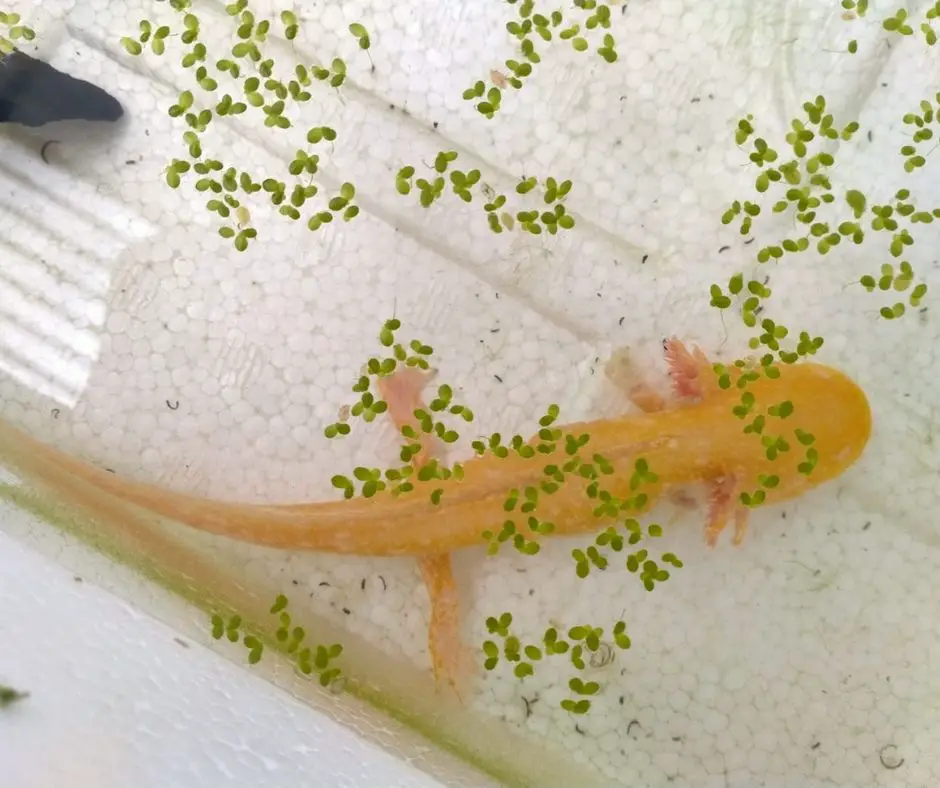
Golden albino axolotl can be identified by their random shiny stripes, and dots found all over their body.
They have a golden yellowish body, and their gills can be golden yellow, red, or pink. They usually have red-eye, but there are species with transparent eyes as well.
The color of the golden axolotl is caused by iridophores in their genes. Golden albino axolotls are usually white when born but will turn golden as they age.
White Albino Axolotl
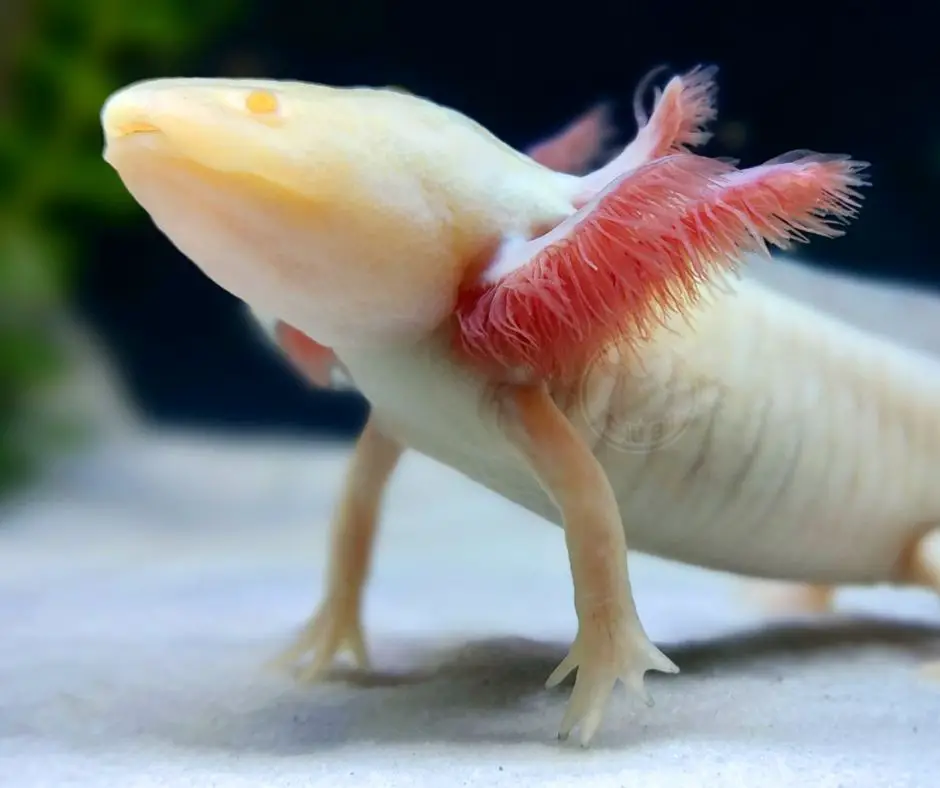
White albino axolotl lacks melanophores and xanthophores but has iridophores solely confined to their gills.
They are usually pure white with pink or white eyes, red gill filaments, and golden flecks on their gill stalk. Young white albinos are almost transparent.
As they grow old, the iridophores on their gills will become deeper red while their body will remain pure white. Many usually mistake white albinos with leucistic axolotls. However, white albinos don’t have pigment in their eyes.
This is why white albinos have a poorer vision and are more sensitive to light, unlike other axolotl morphs.
Black Melanoid Axolotl
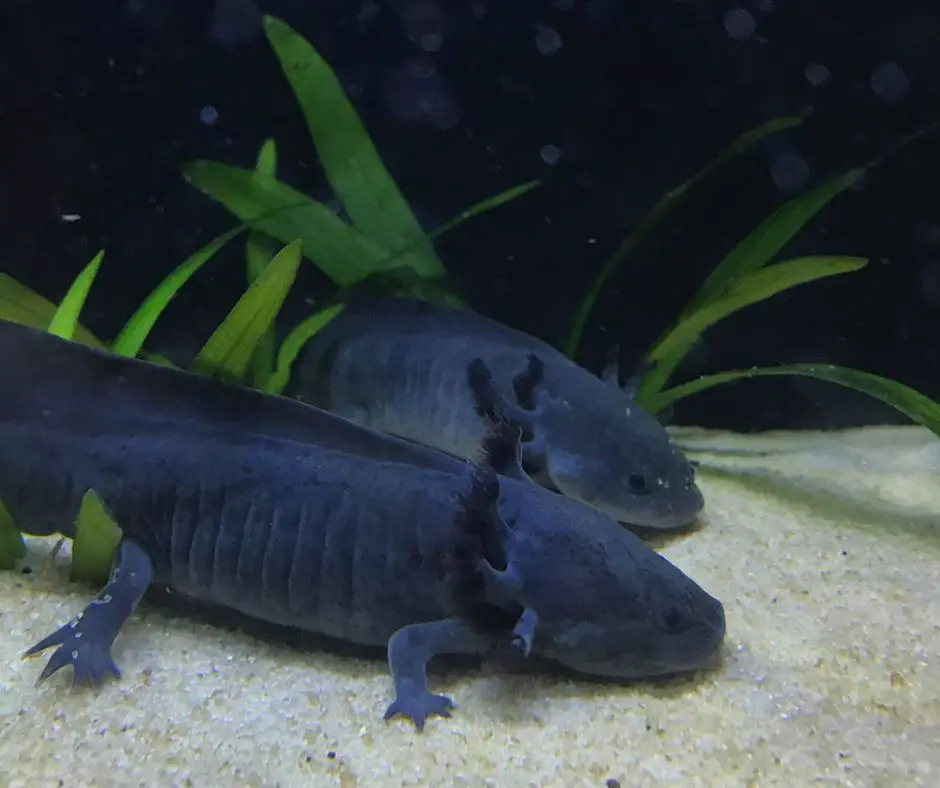
The black melanoid axolotl morphs look similar to the wild morphs. However, a black melanoid is completely dark, and you will not find any specks or dots of different colors on their body.
Unlike other axolotls, melanoid axolotl does not have shiny pigments but melanophores which makes them black.
A melanoid axolotl was first discovered in 1961 in a lab, and it is now a quite common morph in captivity.
Copper Axolotl
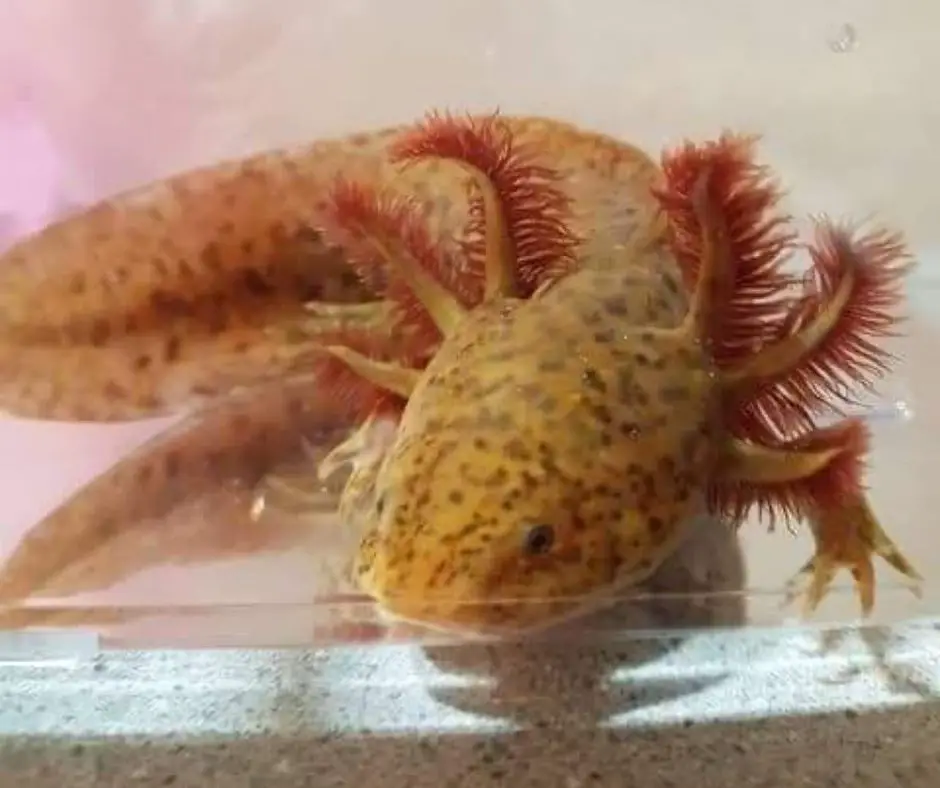
Copper axolotl has a cute face with sandy color, making them one of the popular axolotl morphs. They are commonly found in the US and Australia, where their first lines originated.
The copper axolotl has reduced levels of melanin and pteridine pigments in their genes. You can identify them by their light gray body covered in copper-colored freckles and gray irises. They have a lighter belly and grayish-red gills.
There are even some copper axolotls with caramel color, while some are almost pink. Many breeders breed copper morphs with other morphs to create morphs like axanthic copper and melanoid morphs.
Green Fluorescent Protein Axolotl
This is a cool and uncommon axolotl morph designed mostly in the lab. A green fluorescent protein (GFP) axolotl is green in color and can glow in the dark. They glow in the dark because of a special protein in their genome structure.
A GFP axolotl is created by inducing green fluorescent protein in a regular axolotl breed. You can make them glow by exposing them to UV or black-lighting. However, this can make your axolotl uncomfortable and should not be done very often.
Heavily-Marked Melanoid Axolotl
The heavily marked melanoid axolotls are a unique type of black melanoids. They look similar to black melanoid morphs. However, you can differentiate them by the presence of light green and yellow patches on their body.
Heavily marked melanoids are very rare axolotl morphs, and only a few people own them.
Piebald Axolotl
Piebald axolotl can be identified by their white body with dark green, black, or gray symmetrical patches on their face and back.
They also have black eyes and red gills. Generally, their patterns are usually found on the top half of the body, but some rare species have markings on their sides and legs.
Piebald axolotl patterns usually darken as they grow older and can become black and white salamanders. Piebald axolotl is a very rare axolotl morph. Most breeders of this morph can be found in New Zealand.
Silver Dalmatian / Lavender Axolotl
Silver dalmatians, also called lavender, are among the rarest axolotls morphs out there.
They are known for their light, silvery purple color with black eyes and grayish-red gills. They are called silver dalmatian due to the gray spots covering their bodies.
Furthermore, silver dalmatians have unique specks over their body, and they look like dalmatian dogs. Silver dalmatian morphs can also become gray or green in color as they age, while some will remain purple their whole life.
Many breeders also breed lavender melanoid hybrids to create a darker purple color with no spots. Lavender axolotl morphs are found mainly in the United States as it is only a few breeders that breed them.
Firefly Axolotl
Firefly axolotl is a rare morph of the axolotl, and Lloyd Strohl artificially created it through embryonic graphing. They are dark in color with green fluorescent protein albino tails. Many call them fireflies because only the tail glows under a black light.
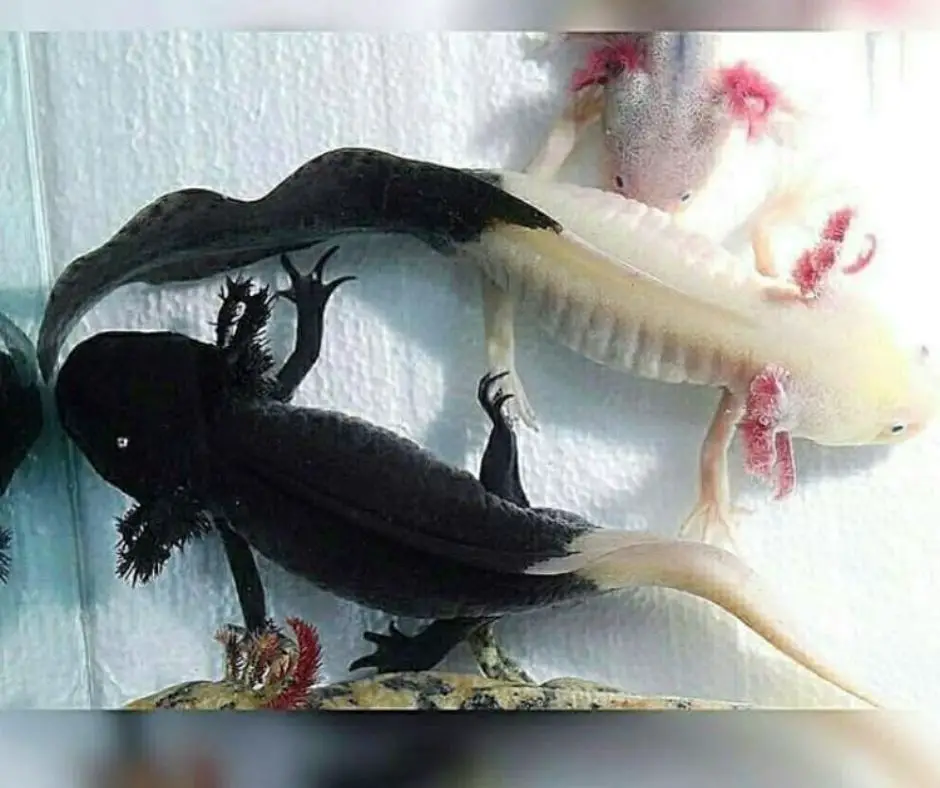
Enigma Axolotl
Enigma is a unique axolotl as it is just an axolotl that is found with this stunning color combination. Not much is known about enigma axolotl genetics due to their rarity. The morph was discovered by a breeder in the United States.
Enigma axolotl has a dark gray body with pale red gills, a white belly and toes, and golden eyes. They also have shiny golden patches that look green from certain angles on their body.
High Iridophore Golden Albino Axolotl
High iridophore golden albino axolotl is a popular golden variation of the albino axolotl.
They produce a huge iridophore cell which makes them look shiny and have stunning iridescent colors when illuminated. They usually become shinier and more yellowish as they age because of the iridophore pigments.
Mosaic Axolotl
Mosaic axolotls can easily be identified by the black, golden, and white flecks on their body.
They may also have striped red and purple gills and multicolored eyes. Mosaic axolotls are rare morphs, and they are not usually available in the market.
This is because they are formed when two eggs fuse into one instead of splitting in the middle. The cell will then display color from either parent randomly.
However, most breeders get mosaic axolotl breeds when combining albino and melanistic parents together.
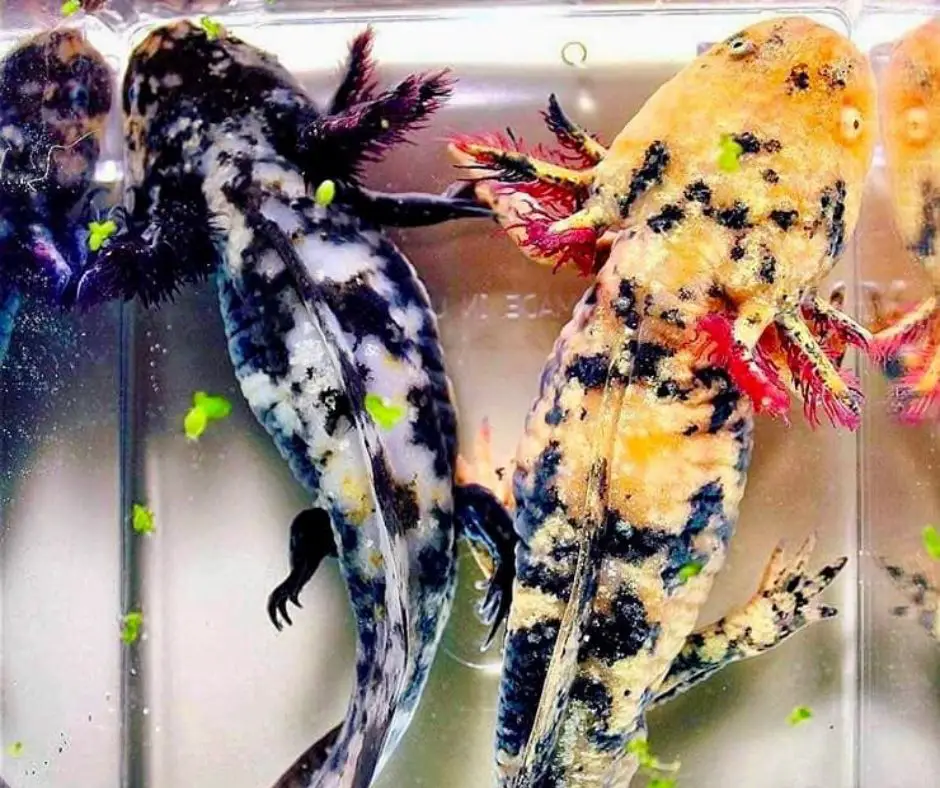
Chimera Axolotl
Chimera is a very rare axolotl morph, and many even consider whether or not it should be called a true axolotl morph.
Chimera morph usually occurs when two developing eggs fuse together, and most eggs do not hatch if it does not fuse completely.
Chimera axolotl shows a morph characteristic on one side and another morph characteristic on the other side.
FAQs
What color are wild axolotls?
Wild axolotls are usually dark grayish-green and have black and olive mottling. They also have a pale belly and speckles of gold on the body.
Are Blue axolotls real?
No, blue axolotls do not actually exist. However, many people usually mistake black melanoids for blue axolotls. This is because black melanoides can look bluish when kept under a certain light.
How much does a baby axolotl cost?
Buying axolotl is not that costly. Depending on where you buy it from, you can get a baby axolotl for around $20, while an adult costs about $35.
Wrapping Up
Axolotls are a perfect example of exotic pets. They are unique, very playful, and you will have a great time just playing with them.
They are also available in a wide range of colors and morphs, which means you can choose a morph based on your preference.
Some of the morphs are common, while some are rare. You can contact the breeders in your area when you plan to buy a morph.
